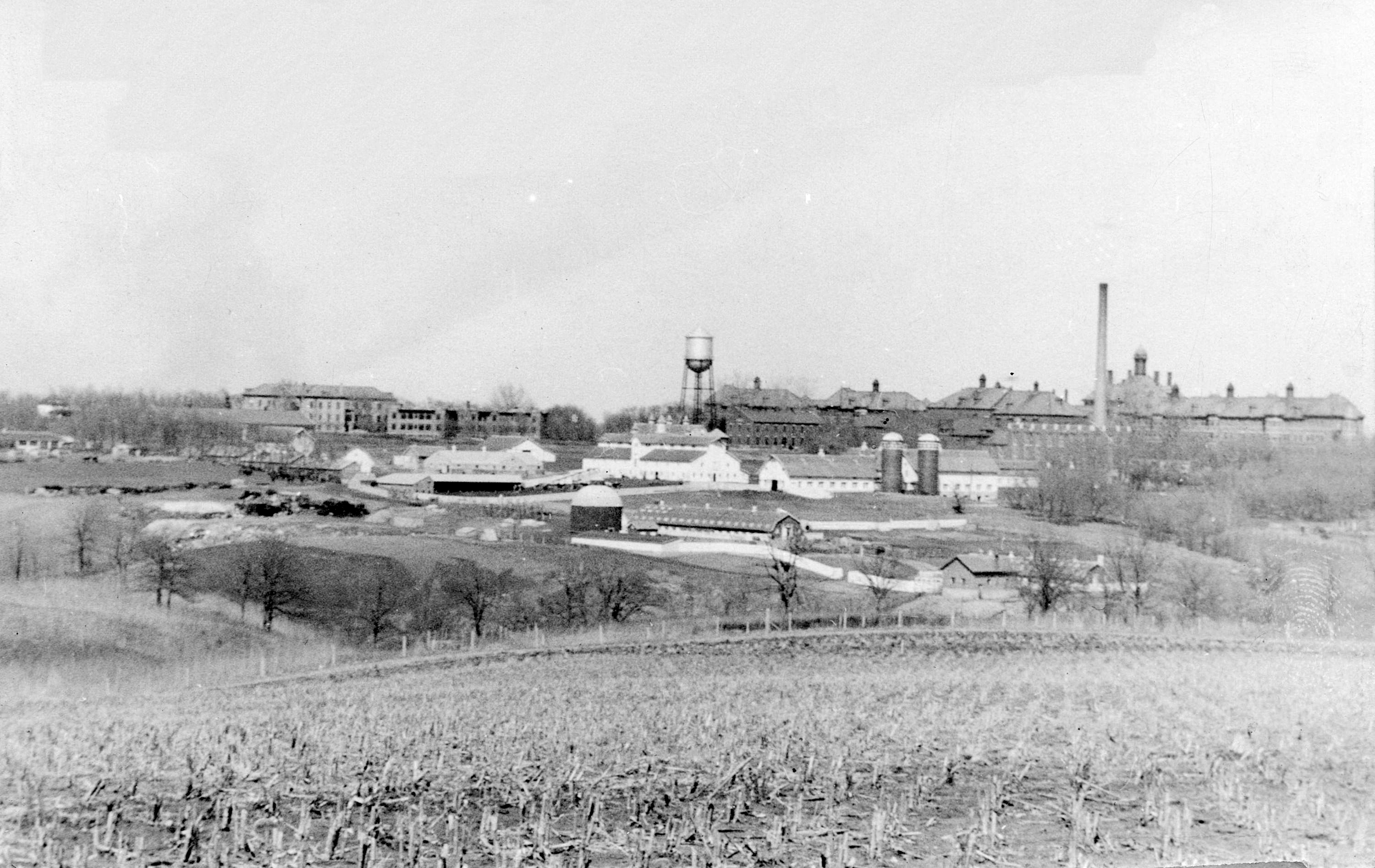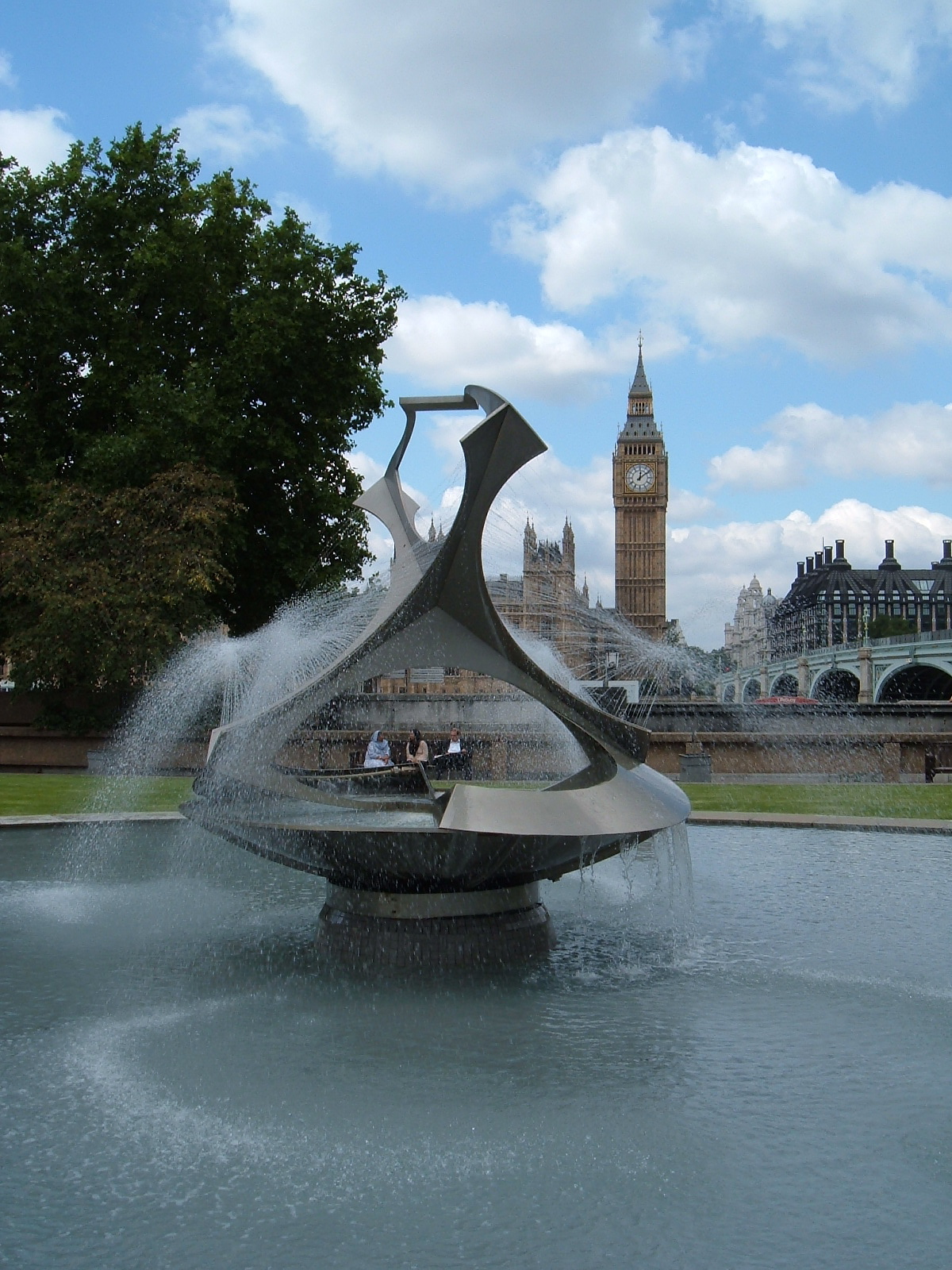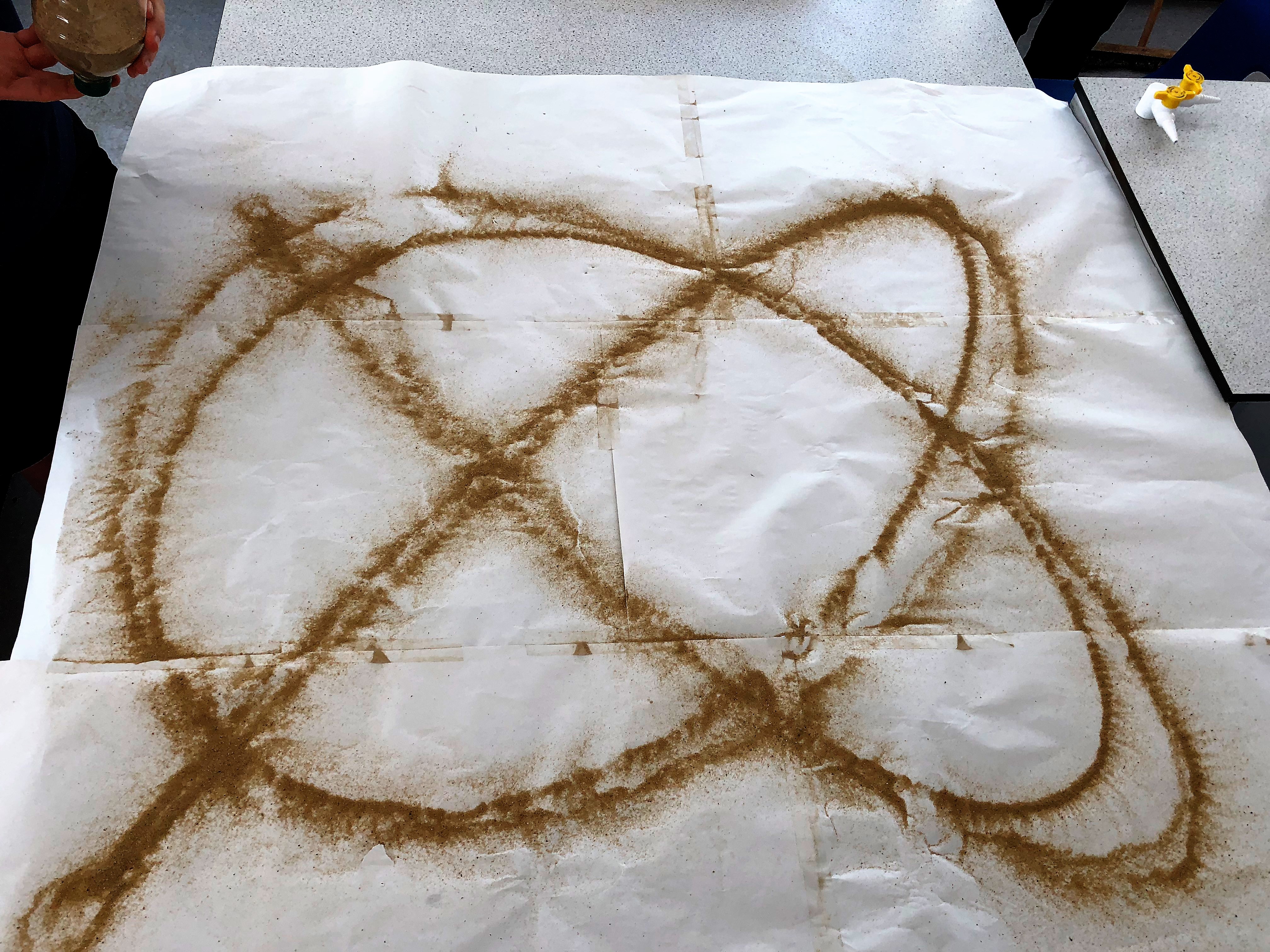|
Ben F. Laposky
Benjamin Francis Laposky (1914 – 2000) was an American mathematician, artist and draftsman from Cherokee, Iowa. He has been credited with making the first computer graphics, utilizing an oscilloscope as the creation medium for abstract art. In 1953 he released what he called "Oscillons" (or oscillogram designs) along with a corresponding thesis entitled "Electronic Abstractions" via a gallery exhibition of fifty pictures of the same name at Sanford Museum in Cherokee. Laposky is often credited as the pioneer for electronic art, more specifically in the analog vector medium. Early life He was born September 30, 1914, on a farm south of Cherokee to Peter Paul and Leona Anastasia (Gabriel) Laopsky. His siblings were named George and Raymond. At age four, his family relocated to Colorado Springs, Colorado. In 1931, Laposky's mother died.Uncredited/Undated report from Cherokee County Archives "CA-22" In 1932, Laposky graduated from St. Mary's High School and shortly thereafter, the ... [...More Info...] [...Related Items...] OR: [Wikipedia] [Google] [Baidu] |
Cherokee, Iowa
Cherokee is a city in Cherokee County, Iowa, United States. The population was 5,199 at the 2020 Census, down from 5,369 in 2000. It is the county seat of Cherokee County. History Cherokee was laid out as a town in 1870, and was named for the Southeast Indian tribe, most of whose members had been removed to Indian Territory in the late 1830s. Cherokee was incorporated on April 5, 1873. Geography According to the United States Census Bureau, the city has a total area of , of which is land and is water. Climate Demographics 2010 census At the 2010 census there were 5,253 people in 2,316 households, including 1,339 families, in the city. The population density was . There were 2,569 housing units at an average density of . The racial makeup of the city was 95.5% White, 1.0% African American, 0.3% Native American, 0.7% Asian, 0.2% Pacific Islander, 1.2% from other races, and 1.1% from two or more races. Hispanic or Latino of any race were 2.9%. Of the 2,316 households 24. ... [...More Info...] [...Related Items...] OR: [Wikipedia] [Google] [Baidu] |
Photography
Photography is the art, application, and practice of creating durable images by recording light, either electronically by means of an image sensor, or chemically by means of a light-sensitive material such as photographic film. It is employed in many fields of science, manufacturing (e.g., photolithography), and business, as well as its more direct uses for art, film and video production, recreational purposes, hobby, and mass communication. Typically, a lens is used to focus the light reflected or emitted from objects into a real image on the light-sensitive surface inside a camera during a timed exposure. With an electronic image sensor, this produces an electrical charge at each pixel, which is electronically processed and stored in a digital image file for subsequent display or processing. The result with photographic emulsion is an invisible latent image, which is later chemically "developed" into a visible image, either negative or positive, depending on the purp ... [...More Info...] [...Related Items...] OR: [Wikipedia] [Google] [Baidu] |
Alexander Calder
Alexander Calder (; July 22, 1898 – November 11, 1976) was an American sculptor known both for his innovative mobiles (kinetic sculptures powered by motors or air currents) that embrace chance in their aesthetic, his static "stabiles", and his monumental public sculptures. Calder preferred not to analyze his work, saying, "Theories may be all very well for the artist himself, but they shouldn't be broadcast to other people." Early life Alexander "Sandy" Calder was born in 1898 in Lawnton, Pennsylvania. His birthdate remains a source of confusion. According to Calder's mother, Nanette (née Lederer), Calder was born on August 22, yet his birth certificate at Philadelphia City Hall, based on a hand-written ledger, stated July 22. When Calder's family learned of the birth certificate, they asserted with certainty that city officials had made a mistake. Calder's grandfather, sculptor Alexander Milne Calder, was born in Scotland, had immigrated to Philadelphia in 1868, and is best ... [...More Info...] [...Related Items...] OR: [Wikipedia] [Google] [Baidu] |
Marcel Duchamp
Henri-Robert-Marcel Duchamp (, , ; 28 July 1887 – 2 October 1968) was a French painter, sculptor, chess player, and writer whose work is associated with Cubism, Dada, and conceptual art. Duchamp is commonly regarded, along with Pablo Picasso and Henri Matisse, as one of the three artists who helped to define the revolutionary developments in the plastic arts in the opening decades of the 20th century, responsible for significant developments in painting and sculpture. Duchamp has had an immense impact on twentieth-century and twenty first-century art, and he had a seminal influence on the development of conceptual art. By the time of World War I he had rejected the work of many of his fellow artists (such as Henri Matisse) as "retinal" art, intended only to please the eye. Instead, Duchamp wanted to use art to serve the mind. Early life and education Marcel Duchamp was born at Blainville-Crevon in Normandy, France, to Eugène Duchamp and Lucie Duchamp (formerly Lucie Nicolle) ... [...More Info...] [...Related Items...] OR: [Wikipedia] [Google] [Baidu] |
Fernand Léger
Joseph Fernand Henri Léger (; February 4, 1881 – August 17, 1955) was a French painting, painter, sculpture, sculptor, and film director, filmmaker. In his early works he created a personal form of cubism (known as "tubism") which he gradually modified into a more Figurative art, figurative, populism, populist style. His boldly simplified treatment of modern subject matter has caused him to be regarded as a forerunner of pop art. Biography Léger was born in Argentan, Orne, Lower Normandy, where his father raised cattle. Fernand Léger initially trained as an architect from 1897 to 1899, before moving in 1900 to Paris, where he supported himself as an architectural draftsman. After military service in Versailles, Yvelines, Versailles, Yvelines, in 1902–1903, he enrolled at the School of Decorative Arts after his application to the École des Beaux-Arts was rejected. He nevertheless attended the Beaux-Arts as a non-enrolled student, spending what he described as "three empty an ... [...More Info...] [...Related Items...] OR: [Wikipedia] [Google] [Baidu] |
Kazimir Malevich
Kazimir Severinovich Malevich ; german: Kasimir Malewitsch; pl, Kazimierz Malewicz; russian: Казими́р Севери́нович Мале́вич ; uk, Казимир Северинович Малевич, translit=Kazymyr Severynovych Malevych ., group=nb (Запись о рождении в метрической книге римско-католического костёла св. Александра в Киеве, 1879 год // ЦГИАК Украины, ф. 1268, оп. 1, д. 26, л. 13об—14. – 15 May 1935) was a ... [...More Info...] [...Related Items...] OR: [Wikipedia] [Google] [Baidu] |
Victor Vasarely
Victor Vasarely (; born Győző Vásárhelyi, ; 9 April 1906 – 15 March 1997) was a Hungarian-French artist, who is widely accepted as a "grandfather" and leader of the Op art movement. His work entitled ''Zebra'', created in 1937, is considered by some to be one of the earliest examples of Op art. Life and work Vasarely was born in Pécs and grew up in Pöstény and Budapest, where, in 1925, he took up medical studies at Eötvös Loránd University. In 1927, he abandoned medicine to learn traditional academic painting at the private Podolini-Volkmann Academy. In 1928/1929, he enrolled at Sándor Bortnyik's private art school called ''Műhely'' (lit. "Workshop", in existence until 1938), then widely recognized as Budapest's centre of Bauhaus studies. Cash-strapped, the ''műhely'' could not offer all that the Bauhaus offered. Instead it concentrated on applied graphic art and typographical design. In 1929, he painted his ''Blue Study'' and ''Green Study''. In 1930, he ... [...More Info...] [...Related Items...] OR: [Wikipedia] [Google] [Baidu] |
Piet Mondrian
Pieter Cornelis Mondriaan (), after 1906 known as Piet Mondrian (, also , ; 7 March 1872 – 1 February 1944), was a Dutch painter and art theoretician who is regarded as one of the greatest artists of the 20th century. He is known for being one of the pioneers of 20th-century abstract art, as he changed his artistic direction from figurative painting to an increasingly abstract style, until he reached a point where his artistic vocabulary was reduced to simple geometric elements. Mondrian's art was highly utopian and was concerned with a search for universal values and aesthetics. He proclaimed in 1914: "Art is higher than reality and has no direct relation to reality. To approach the spiritual in art, one will make as little use as possible of reality, because reality is opposed to the spiritual. We find ourselves in the presence of an abstract art. Art should be above reality, otherwise it would have no value for man." His art, however, always remained rooted in nature. H ... [...More Info...] [...Related Items...] OR: [Wikipedia] [Google] [Baidu] |
Joan Miró
Joan Miró i Ferrà ( , , ; 20 April 1893 – 25 December 1983) was a Catalan painter, sculptor and ceramicist born in Barcelona. A museum dedicated to his work, the Fundació Joan Miró, was established in his native city of Barcelona in 1975, and another, the Fundació Pilar i Joan Miró in Mallorca, Fundació Pilar i Joan Miró, was established in his adoptive city of Palma de Mallorca, Palma in 1981. Earning international acclaim, his work has been interpreted as Surrealism but with a personal style, sometimes also veering into Fauvism and Expressionism. He was notable for his interest in the unconscious or the subconscious mind, reflected in his re-creation of the childlike. His difficult-to-classify works also had a manifestation of Catalonia, Catalan pride. In numerous interviews dating from the 1930s onwards, Miró expressed contempt for conventional painting methods as a way of supporting bourgeois society, and declared an "assassination of painting" in favour o ... [...More Info...] [...Related Items...] OR: [Wikipedia] [Google] [Baidu] |
Naum Gabo
Naum Gabo, born Naum Neemia Pevsner (23 August 1977) (Hebrew: נחום נחמיה פבזנר), was an influential sculptor, theorist, and key figure in Russia's post-Revolution avant-garde and the subsequent development of twentieth-century sculpture.Tate GalleryNaum Gabo biography. Retrieved March 23, 2018./ref> His work combined geometric abstraction with a dynamic organization of form in small reliefs and constructions, monumental public sculpture and pioneering kinetic works that assimilated new materials such as nylon, wire, lucite and semi-transparent materials, glass and metal. Responding to the scientific and political revolutions of his age, Gabo led an eventful and peripatetic life, moving to Berlin, Paris, Oslo, Moscow, London, and finally the United States, and within the circles of the major avant-garde movements of the day, including Cubism, Futurism, Constructivism, the Bauhaus, de Stijl and the Abstraction-Création group.Hammer, Martin and Naum Gabo, Christina Lo ... [...More Info...] [...Related Items...] OR: [Wikipedia] [Google] [Baidu] |
Lissajous Curve
A Lissajous curve , also known as Lissajous figure or Bowditch curve , is the graph of a system of parametric equations : x=A\sin(at+\delta),\quad y=B\sin(bt), which describe the superposition of two perpendicular oscillations in x and y directions of different angular frequency (''a'' and ''b).'' The resulting family of curves was investigated by Nathaniel Bowditch in 1815, and later in more detail in 1857 by Jules Antoine Lissajous (for whom it has been named). Such motions may be considered as a particular of kind of complex harmonic motion. The appearance of the figure is sensitive to the ratio . For a ratio of 1, when the frequencies match a=b, the figure is an ellipse, with special cases including circles (, radians) and lines (). A small change to one of the frequencies will mean the x oscillation after one cycle will be slightly out of synchronization with the y motion and so the ellipse will fail to close and trace a curve slightly adjacent during the next orbit sho ... [...More Info...] [...Related Items...] OR: [Wikipedia] [Google] [Baidu] |






